What’s inside this article: A variety of sensory room ideas for schools, clinics, and homes that help create an enjoyable multisensory experience for children
Disclaimer: This post contains affiliate links
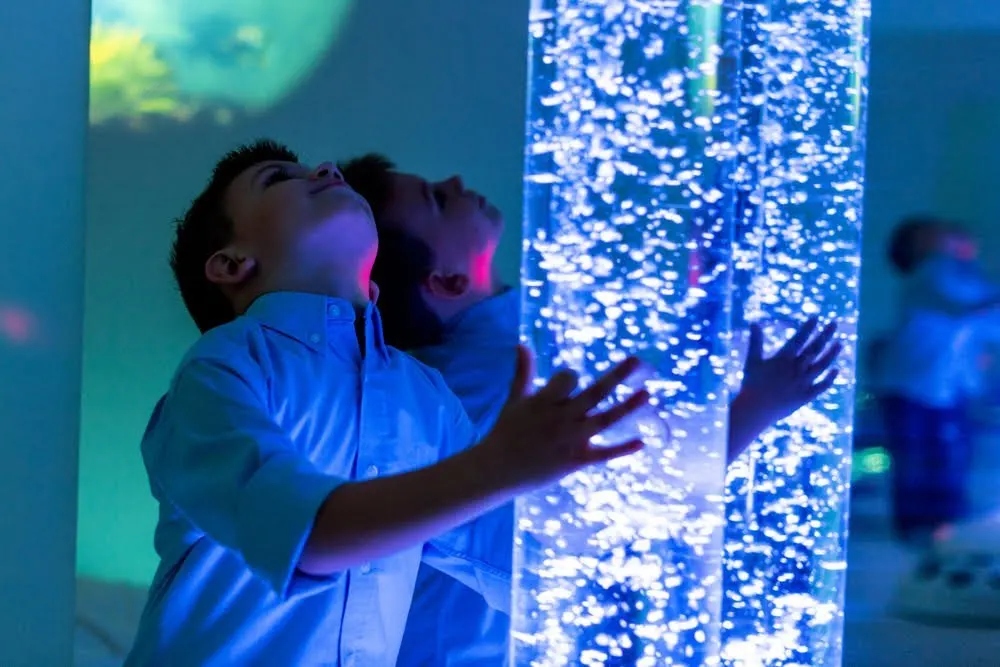
What Is A Sensory Room?
A sensory room, also sometimes known as a multisensory environment, is a room specifically designed to provide an enjoyable or calming multisensory experience for children.
Sensory rooms are adaptable spaces tailored to the specific needs of the individual, providing therapeutic benefits and promoting overall well-being.
Sensory rooms are becoming more common in clinics, schools, and even popping up elsewhere – like airports and malls.
Having a sensory room in your home will support your child’s sensory needs on a daily basis.
Uses and Benefits of Sensory Rooms
There are numerous purposes and uses, including:
- Therapeutic Benefits: Sensory rooms have therapeutic benefits for kids with sensory processing disorders, autism, developmental delays, trauma, anxiety disorders, and other conditions.
- Relaxation and Stress Reduction: Soft lighting, tranquil sounds, and comfortable seating areas in sensory rooms can help reduce stress and anxiety.
- Stimulation: Sensory rooms can provide engaging stimuli for sensory seekers. These include colored lights, tactile toys, climbing equipment, and engaging scents.
- Learning & Development: Multisensory environments activate different areas of the brain simultaneously, which helps enhance learning by building neural pathways more quickly, leading to improved cognitive function, creativity, and learning capacity.
- Motor Skills Development: Sensory rooms often have equipment or activities that promote the development of fine and gross motor skills.
- Behavioral Improvement: Sensory rooms can provide a safe space for kids to self-regulate and reduce instances of aggressive or disruptive behaviors, particularly when these behaviors are caused by sensory overload.
- Sensory Integration: Sensory rooms help kids process and react to sensory information more effectively, integrating and responding to sensory information better.
- Safe Exploration and Integration: The controlled environment provides a safe space where children can explore sensory stimuli at their own pace without feeling overwhelmed. This helps with sensory integration as they can better practice responding to sensory information.
Not Enough Room for a Sensory Room?
I know many people don’t have a spare room in their homes to convert to a sensory room, and if that’s the case, it’s okay. You can still create an amazing multi-sensory environment; you just need to get creative.
A sensory room doesn’t actually need to be a room – you can make a sensory corner in your living room or bedroom or use a medium to large-sized closet space.
Consider using a room-divider blackout curtain to section off a part of another room to build your sensory space. This will help dim the lighting as well, which is helpful for children who are sensitive to some visual input.
If you’re using a closet or small storage space without a door and you’d like to create some privacy but are worried about curtains being pulled down and damaging the walls, I recommend hanging them with magnetic tape instead. They can be easily hung up again if they come down.
SensoryRX
SensoryRX offers a Residential Space-Saving Sensory System™ that’s perfect for homes that are tight on space. The entire system stores away on the wall in less than 20 minutes when you need room for other activities, and it’s highly customizable.

SensoryRX can also help you navigate the use of any grants, financial assistance, or state waivers and they provide free consultations so you can ensure you’re investing in the right sensory equipment for your child.
What to Consider When Creating a Sensory Room
There are some things to keep in mind when creating a sensory room. When planning ahead, carefully detail the following:
- Purpose & Goals:
- Define the primary goal: relaxation, stimulation, skill development, etc.
- Space & Location:
- Size and layout of the room.
- Proximity to noisy or busy areas.
- Accessibility for users with mobility challenges.
- Lighting:
- Adjustable lighting options.
- Avoidance of harsh or overly bright lights.
- Use of calming colored lights or light projectors.
- Acoustics:
- Soundproofing or noise reduction.
- Incorporation of calming sounds or music.
- Availability of noise-canceling options.
- Flooring:
- Soft and safe flooring materials.
- Consideration of padding or cushioning.
- Use of tactile mats or rugs.
- Sensory Equipment:
- Selection of appropriate sensory equipment, toys and tools.
- Equipment for tactile, visual, auditory, olfactory, and gustatory stimulation.
- Safety and durability of equipment.
- Furniture:
- Soft and comfortable seating.
- Swing or rocking chairs for vestibular stimulation.
- Consideration of storage for sensory tools and toys.
- Decor:
- Wall colors and patterns that align with the room’s purpose.
- Use of murals, decals, or visual displays.
- Avoidance of overly stimulating or busy decorations.
- Safety:
- Secure storage for small items or potential choking hazards.
- Use of non-toxic materials.
- Installation of padded corners or edges.
- Customization & Flexibility:
- Ability to change or adjust the room based on individual needs or as the user’s needs change.
- Consideration of age-appropriateness.
- Budget:
- Determining a budget for setup and maintenance.
- Prioritizing essential items vs. nice-to-have additions.
- Feedback & Adjustment:
- Obtaining feedback from users.
- Willingness to make changes based on experiences and feedback.
Considering these factors will help in creating a sensory room that is both functional and beneficial for its users.
Sensory Room Ideas
Flooring
Flooring needs to be soft enough that if a child falls or crashes into it, they won’t be injured. Hard flooring is not recommended.
Also, if your room is located somewhere with a concrete floor (such as your basement), you should also have extra padding in place. It doesn’t take much to cause an injury with insufficient flooring.
Flooring Ideas:
- In areas where your child may jump or fall while playing, use quality interlocking foam tiles, as opposed to the thinner, flimsy ones available at dollar stores.
- Place additional padding protection in higher-risk areas, for example, underneath any climbing equipment in the room.
- Gel floor tiles in safe areas allow even the floor of your sensory room to be part of the overall experience. Invite kids to sit, jump, or step on the tiles and watch the colors ooze.
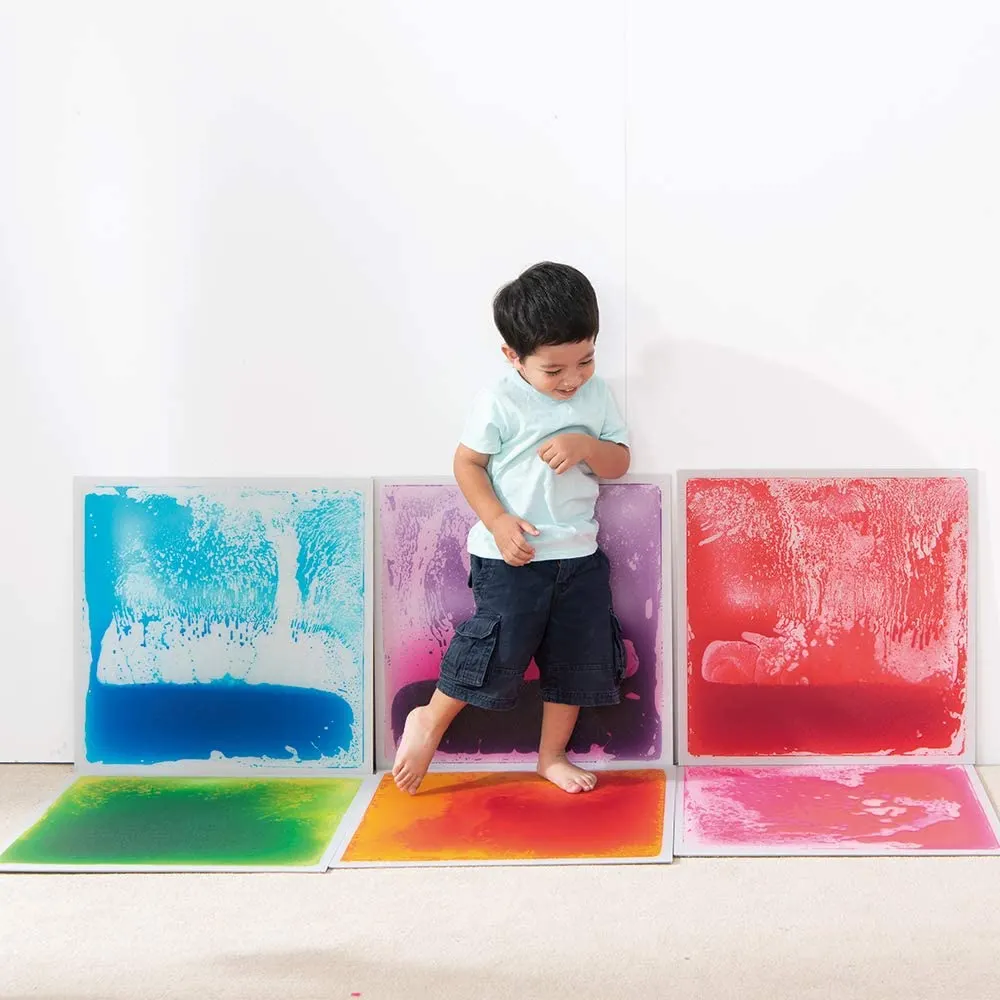
Lighting
The lighting in your room is an important part of the overall sensory experience. The right lighting creates a calming environment that is almost mesmerizing and helps prevent meltdowns.
Bright fluorescent lights that are common in classrooms are overstimulating and should be avoided or dimmed.
The lighting you chose needs to support the type of atmosphere you are creating.
Lighting Ideas for Sensory Rooms:
- If the room has large fluorescent lights, they should be dimmed. A lot of people are sensitive to fluorescent lights, and they can actually contribute to overstimulation. You can purchase covers that dim them.
- Galaxy Light Projector — Projects LED lights on the ceiling that create a soothing galaxy effect. This is great for helping with relaxation, and it’s equipped with Google Home and Amazon Alexa, so it’s voice-activated and can play music.
- Bubble tube — I’m starting to see these more frequently in waiting areas for children, and the kids always enjoy watching them. They’re a great tool for helping kids stay calm.
- Fiber optic light cascade — These lights basically make a color-changing curtain of flexible lighting. My son actually likes to lay on the floor underneath them and look up at them or put them over his face, close to his eyes.
- Tap Tap LED Lights — These make a great addition as lighting and as a sensory tool; they turn on and off individually with touch but interlock together. Kids can use these for both visual and tactile sensory input.
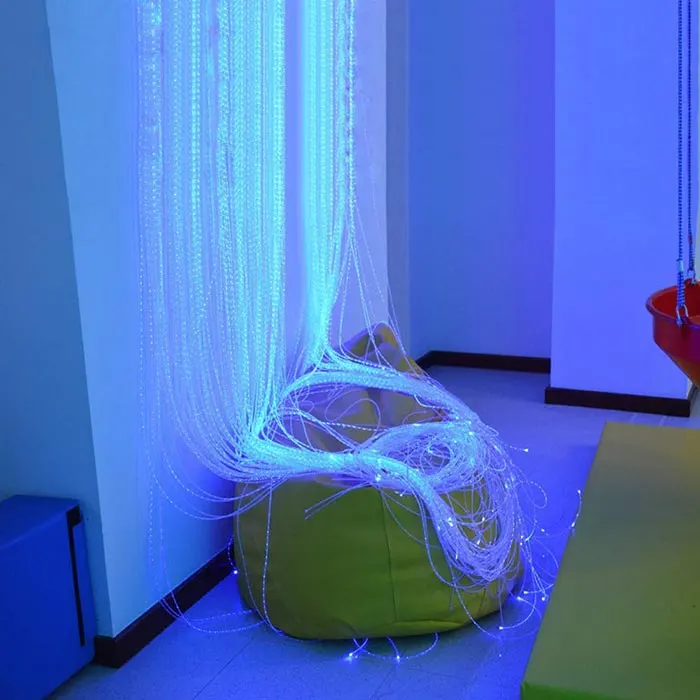
Sensory Room Equipment & Furniture
The sensory equipment and furniture are the heart of the room. You want to choose equipment that is durable and supports your child’s unique sensory needs.
What’s the goal of your sensory room? Calming? Active? Both? Schedule a consultation with SensoryRX for expert sensory equipment recommendations.
Furniture and Equipment Ideas:
- Space-Saving Sensory Equipment Systems — This equipment is great because when you need the space for other activities, you can easily fold it away, This makes it workable in smaller spaces or if you just want it out of your way to have some extra playroom sometimes. There are residential and commercial space-saving systems.
- Sensory Swings—A sensory swing is a great addition to any sensory room, whether the goal is to be calming or alerting. Swinging has many benefits for sensory integration – read about the benefits of swinging and the different types of sensory swings here.
- Rocking Seating — Rocking is a calming source of vestibular input that can help seekers who are constantly moving. If you have enough space for it, this concentration rocker is durable, comfy, and easy to clean.
- Wobble Board — These simple yet extremely versatile boards stimulate the vestibular system and are a great addition to any sensory room. They work great as seating, for balancing on, sliding on, climbing over, etc.
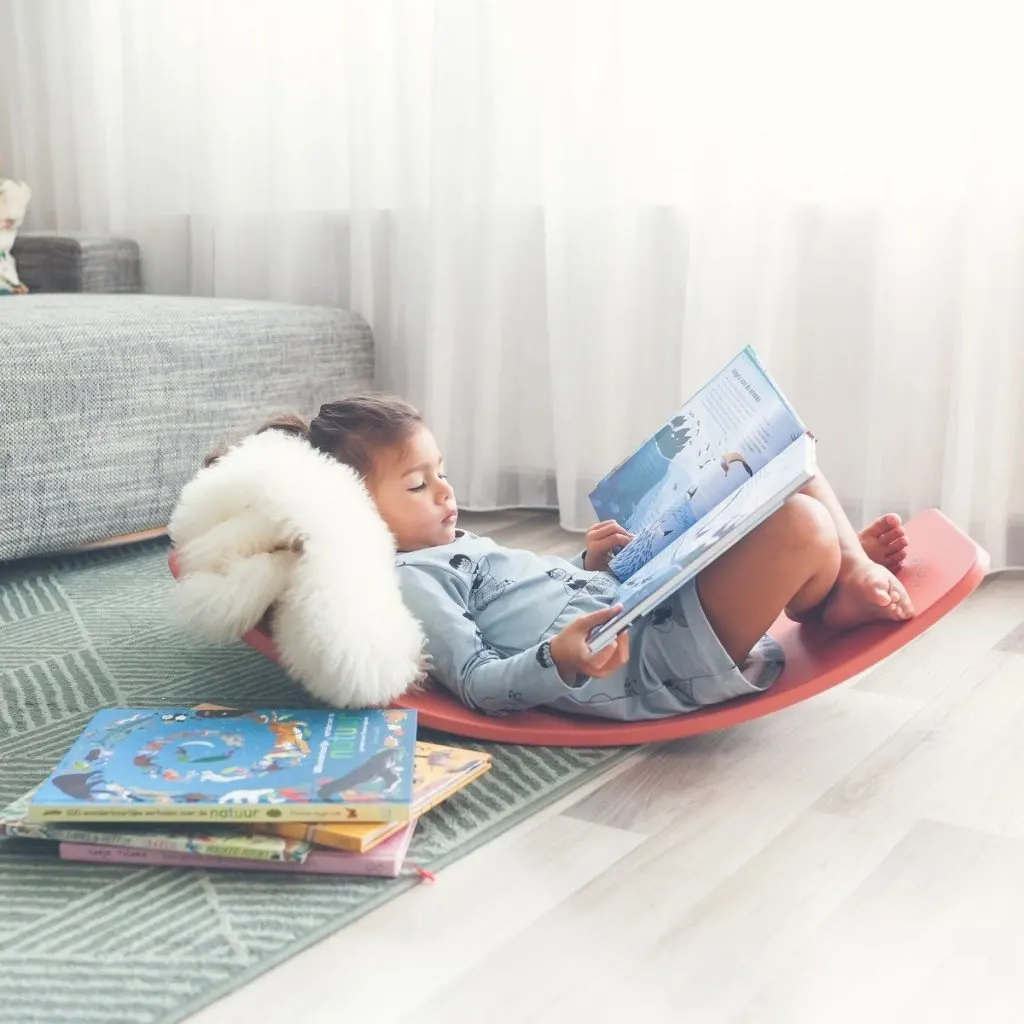
- Bean bag chair — Choose a bean bag chair that is big and durable enough that your child can safely jump into it and climb around, rather than having it strictly as a seat.
- Ball pit — Ball pits are a great source of proprioceptive input because the balls provide extra pressure all over the body. A quality ball pit will have sturdy sides that won’t collapse if your child leans over them. Also, shop for “crush-resistant” balls, or else you will be frequently replacing them.
- Exercise Ball — Exercise balls are a great seating and play option for a sensory room, they help with balance and stability. However, a word of caution — If there are lights on the ceiling, you may not want an exercise ball in this space because I know from experience they will be thrown up to bounce off the ceiling.
- Sensory Tent — Many children like to hide when they’re overstimulated — this is a normal stress response — so providing a safe hiding spot that provides lots of privacy and calming sensory input can significantly reduce dysregulation. You could even create a mini sensory room inside the tent if space is limited. The HugglePod Hangout Tent is designed to block out external feedback and create a desensitizing environment.
Sensory Toys and Fidgets
Keep several age-appropriate sensory toys and/or fidgets in the room for your child to use and play with.
There are many possibilities depending on what your child likes. I wouldn’t keep anything in the room that could get messy like slimes or putties, however here are some toy ideas for your sensory room.
- Pop Its
- Textured sensory balls
- ABC Look-and-feel bag
- Weighted items, for example, these weighted animals with reversible sequins for fidgeting, or weighted lap pads, blankets, etc.
- Touch and feel books
- Mental Blox, or for younger kids, Mental Blox Jr.
- Scented squishy toys, or plushies
- Hopper ball
- Interactive wall panels
You can even purchase bundles of sensory toys and fidgets on Amazon, and easily have a bin ready to go for breaks and sensory exploration.
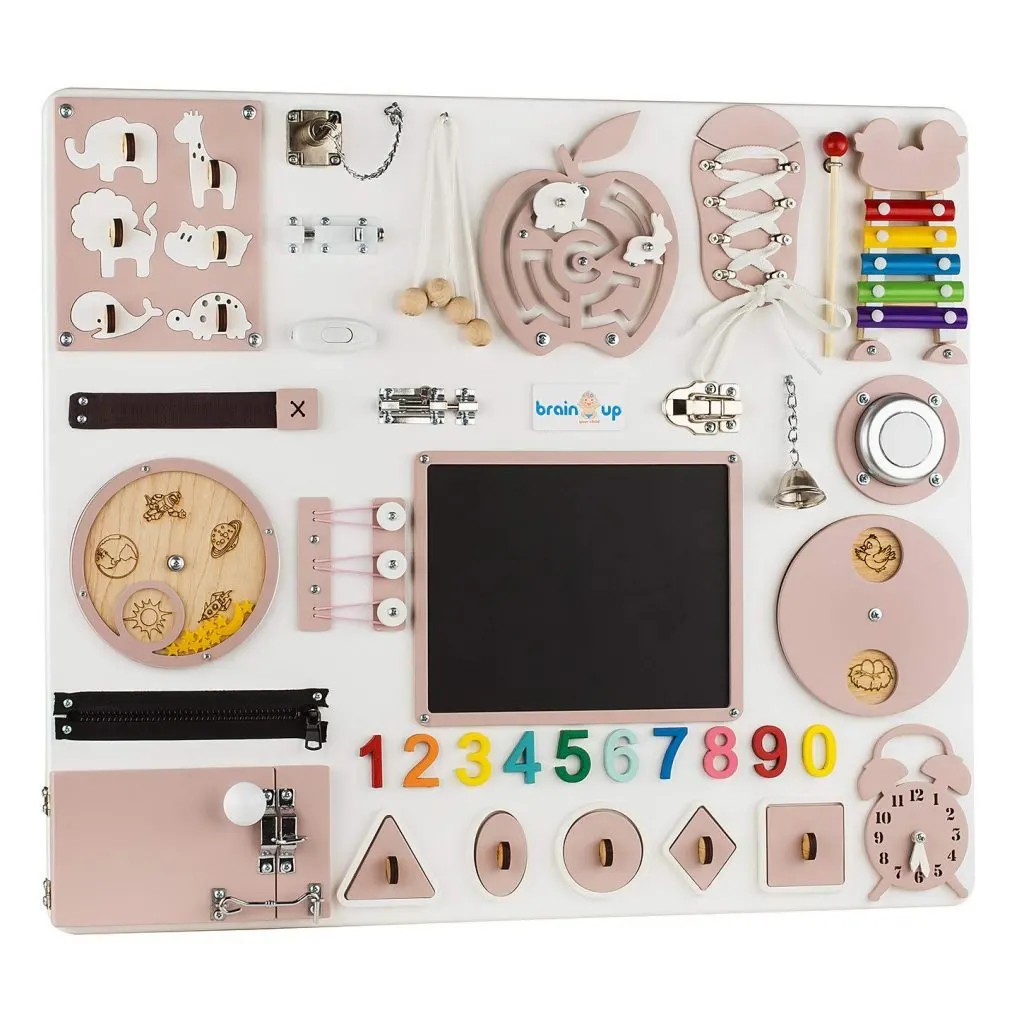
Decor
With flooring, lighting, equipment, and toys ready for your sensory room, all that’s left is decor ideas to bring it together and add the finishing touches.
If your child gets overwhelmed by too much visual sensory input, don’t overdo it with colors and patterns. It’ll be overstimulating.
Sensory Room Decor Ideas:
- Paint the walls a dark color like navy blue or burgundy to accentuate the effects of fiber optic lighting.
- Add glow-in-the-dark wall decals
- These floor and wall decals are designed for kids who need to “Get the wiggles out”
- Self-adhesive mirror tiles; they aren’t made of glass, so they can’t break, making them a safe option for your sensory room.
- Set up an area of the room as a calming corner with self-regulation posters – see how to build a calming corner here.
Commercial Sensory Room Design
Schools, clinics, or other businesses looking to add sensory equipment to their space should reach out to SensoryRX. They will help you design a sensory system that suits your space, needs, and budget.
Including sensory equipment in schools, clinics, community centers, and businesses like malls or airports enhances accessibility and inclusivity for people with diverse needs.
As a business, showing awareness and accommodation for people with sensory needs enhances your reputation and demonstrates that your company values inclusivity and care, making it more attractive to a broader demographic.
You may even be able to access funding for your equipment grants, government aid, or fundraising.



Michelle Warrick
Saturday 11th of January 2020
My son is in need of a sensory room. Please help me do this one a very low budget he needs to do bad.
The Best Gift Ideas for Autistic Children - Raising an Extraordinary Person
Sunday 10th of November 2019
[…] These are also a great addition to sensory rooms. […]